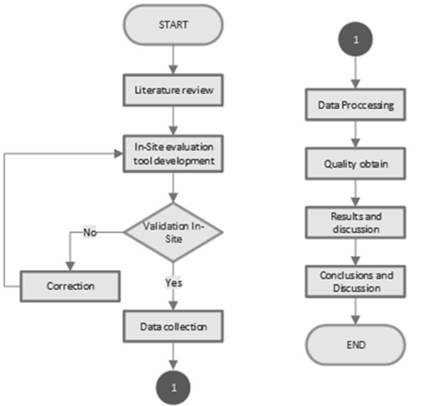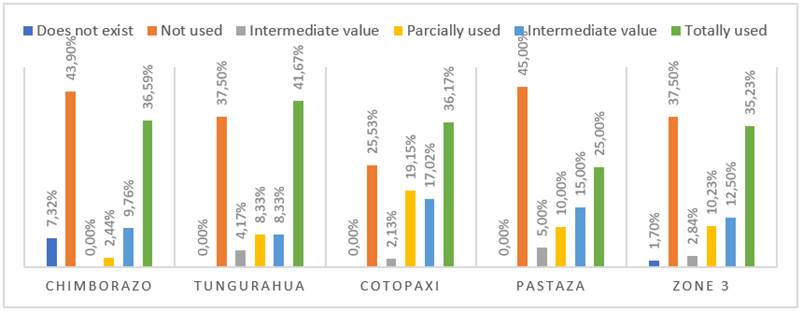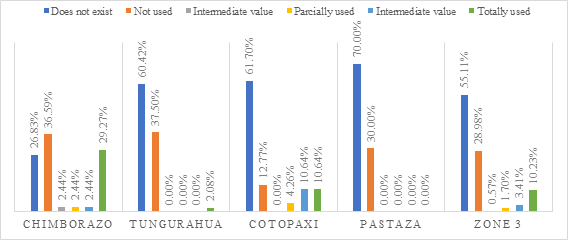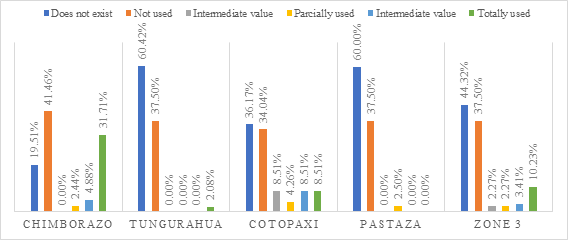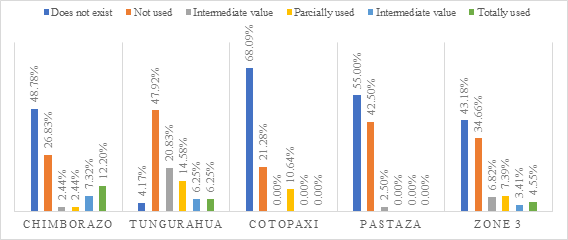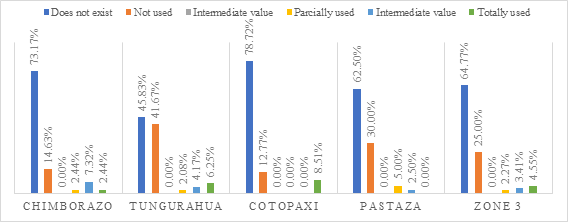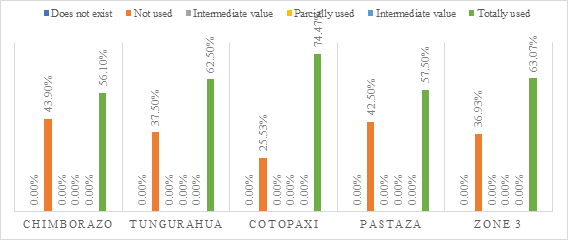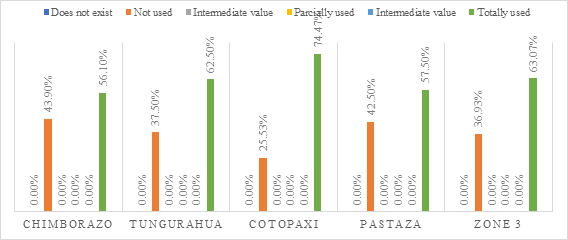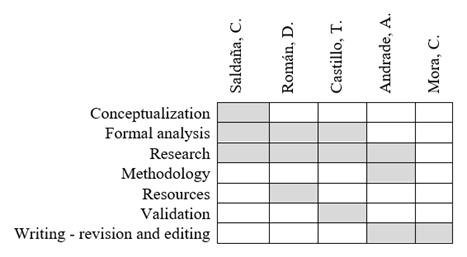Introduction
The construction project is based on previously elaborated studies and designs, including deliverables such as plans, TS, budget, and schedule. In addition, a contract containing the design and construction, aiming to anticipate in all aspects to resolve any doubts that may arise.
One of the most important documents are the TS (Bach, 1993), these are the “Game Rules” that can assure that the construction phase will be developed with quality and don’t present future severe problems. According to (Ávila Espinoza, 2015; Hauser, 1993) the quality is known as the level in which a product accomplishes the TS that were established on the design.
TS are elaborated during the design phase and afterward verified by control entities, in this stage is very important to make sure that the construction process would accomplish them and the design needs as well the TS should describe all the construction requirements for each item (Construction Specifications Institute (CSI), 2011). (Rodas, 2013), mention that the TS is marked by low exigency from the control agencies that approve the project’s design, causing low-quality projects, having sometimes resulted away from the desired product and taking difficulties to the project contractor.
The specifications sheets describe the products, materials, equipment and work required by a construction contract. The contract helps to manage the project development during the construction phase aiming to achieve the project goals. Specifications and contract documents must be studied and designed to lead into their feasibility. The TS contain essential information for the correct construction execution. Though a high level of detail is needed to achieve the contract goals without drawbacks in cost and time of execution (Kubba, 2012). TS should include the client expectations and include technical aspects detailed in laws, norms or technical national regulations; in the absence of such normative, international similar instruments are applicable.
TS should be contained in a technical document unique and basic for the project execution. Each one of the project elements should be described according to their characteristics. Depending on what is written, it will allow making decisions on the method for its accomplishment. Specifications should be clear, complete, and not ambiguous on their interpretation (Ribeiro & Berry, 2020), being the TS a fundamental guide for the project execution.
There is a lack of control in the preparation and approval of TS without being verified. Most of them are copied from similar projects that are not related to the nature of the project and do not help resolve doubts, leading to problems in the execution and supervision of project construction (Hall, 2017). Bach (1993) and (CSI, 2011) indicate that each specification must have at least the following basic sections: element description and its relevant characteristics, required material for its execution, minimum equipment, with its characteristics, workmanship, and sequence, laboratory tests and accepted tolerances, measurement or quantification and payment procedure.
Since the bibliography mention that poor quality occurred in more than 80% of TS (Olanrewaju & Lee, 2022), the first hypothesis is that at least half of the projects present bad quality on their TS due to bad project design and that is causing multiple problems in the construction works (Maseko, 2017; Maluleke, 2018). Also, (Contraloría General del Estado, 2014; Khalifa & Mahamid, 2019) mention that error rectifications in construction and specification changes cause an increase in time and budget of projects.
Considering the quality as a balance between expectations and reality, say the reality should be higher or equal to the expectations (WagMob, 2013). However, TS quality has been poorly analyzed and literature is scarce on the theme. Looking to fill the gap this research looks to evaluate the TS based on an expectation-reality relationship. For such purpose, a sample of 30 public construction projects in Ecuador was analyzed. Zone 3 was selected for this assessment according to the similarities between their bid conditions.
Having the document with an adequate description, clear specifications, and coherent comprehension by all the stakeholders leads a project to have better quality (Olsen, 2015). The quality is considered as the level on which a project accomplishes the expectations, defined on the technical specifications stablished when it was designed since TS are aiming to make real the design during the construction.
Methodology
A literature review was conducted to establish the main aspects that should be considered and detailed in a TS. Key words as technical specifications, construction and project were used in Scopus scientific database since there are the most construction related papers published. Also, a web search using Google Scholar on the same key words was carried out to find books related to construction specifications. The research time line was ten years starting in 2012, and papers were selected based on keywords: technical specifications, quality, evaluation, management.
As result of the documental research, seven basic sections were identified as indispensable to define adequately a TS: element description, required material, minimum equipment required, work’s procedure, tests and tolerances, measurement and payment procedure.
Data was collected starting with public construction projects located in the capital of each province to search for projects that were in progress. Only 2019 construction project´s tenders were selected because in that year the national total amount invested in this contract mode was 11,690.8 million dollars, in the construction industry, representing 10.9 percent of the gross domestic product of Ecuador (GDP) (Secretaria Nacional de Planificación, 2021).
Projects currently in construction were included in the research, since the purpose was to obtain the evaluation of the use of the TS Document, verifying if were being applied as they were written, aiming to achieve the best results for the project. The research presented a qualitative focus using techniques of structured observation to pick the necessary information (Hernández et al., 2010). The procedure detailed in Figure 1 was developed.
To qualify TS in the construction phase, a site evaluation was made in each project, analyzing up to 7 different basic sections, each one was ranked individually on the scale from 0 to 5 depending on the criteria show in the Likert’s scale (Table 1).
The quality levels were defined as follows: level 0, which is the lowest quality of the TS, occurs when one or more of the basic sections does not exist in the document. Level 1 is when all the sections exist in the document but are poorly written, which makes its application impossible. Level 3 is when all the sections exist in the document but are partially applied on site due to any written deficiencies or non-coincidence with the construction method and, lastly level 5 corresponds to a good quality specification that allows its full application on site. Levels 2 and 4 correspond to intermediate values that are appreciated by the evaluator.
Table 1: Scale adopted for basic section
| 0 | 1 | 2 | 3 | 4 | 5 |
|---|---|---|---|---|---|
| The section doesn’t exist | Not Applied | Intermediate Value low | Partially Applied | Intermediate value high | Totally Applied |
Since Likert scales have been criticized due to response bias (Bloom & Van Reenen, 2010), six options in the scale were used because is easy reading for its selection, choosing the intermediate value means that tend to its superior immediate, also the scale facilitate the analysis by organizing them in groups.
To obtain the data 38 construction projects were visited but in eight of them the project managers declined their participation arguing lack of time or a plain refuse. In a few of those projects, managers were aware that TS had flaws and preferred not to be part of the research. The data obtained is based on direct evaluations carried out on-site with the presence of the project manager of each of the 30 projects.
As the data were taken according to the willingness of the construction managers, 167 different items were obtained in the provinces of zone 3 in Ecuador. The number of items evaluated is detailed in Table 2.
Table 2: Scale adopted for each basic unit
| Province | Visited Projects | Evaluated Items |
| Chimborazo | 7 | 41 |
| Tungurahua | 8 | 48 |
| Cotopaxi | 8 | 47 |
| Pastaza | 7 | 40 |
| Zone 3 | 30 | 176 |
The on-site evaluation was developed during 20 working days at the four provinces of Ecuador’s Zone 3.
The reliability of the survey applied was verified with the Alpha coefficient of Cronbach, the used instrument is evidenced for its analysis as convenient for the study and for their good interpretation, with a value of 0,68.
Being evaluated the total of concepts (176). As a resume, the Cronbach Alpha coefficient is resumed by province in Tabla 3.
Table 3: Province Reliability coefficient resume
| Province | Number of elements | Cronbach Alpha |
| Chimborazo | 41 | 0.76 |
| Tungurahua | 48 | 0.62 |
| Cotopaxi | 47 | 0.65 |
| Pastaza | 40 | 0.58 |
A database was created with the values obtained with the survey in each basic section of each project. Next, the project data was grouped by basic section and by province. A weighted average of the quality of the specifications in each province and a global weighted average of all evaluated sections was calculated.
Quality of the TS was calculated by the relation expectation-reality using the statistical frequency of each value as shown in the following (Montero, 2007).
(3) Quality=Reality/Expectation*100
(4) Quality= ( i=1 5 𝑓𝑖∗𝑖 /(𝑛∗5) )*100
Where:
i = score
fi = frequency for the score i
n = quantity of analyzed sections
The quality of the sample of TS was calculated for each section and obtained the weighted average for the 1232 sections by the following formula:
Results
The following subsections are described the data tabulation of the on-site evaluation, having the 176 concepts evaluated on the 7 basic sections that a technical evaluation should have as above described.
Basic Section 1 (Element Description)
The results obtained for Zone 3 analyzing data from Chimborazo, Cotopaxi, Tungurahua, and Pastaza show the importance of each technical specification having a correct description. 1.70% of the items do not have a detailed description in the technical specification, which is important for the product or material to be installed correctly. 37.50% of the items have a description within the specification; however, this is not valid because it does not adequately describe the proposed element. Only 35.23% of the technical specifications used a correct and complete description of the element. Thus, we find that 64.77% of the analyzed specifications have defects that discourage their partial or total use.
Basic Section 2 (Required Material)
In Figure 2, it can be identified that analyzing all the provinces belonging to Zone 3, 55.11% do not have the required materials within the technical specifications, which could be a reason for the owner to accept or reject materials that do not meet their expectations. Additionally, in 28.98% of the items, the required material in the specification is not used due to poor detailing. Only in 10.23% of the cases is there an adequate description. It is important to note that in the province of Pastaza, the absence of the required materials in the technical specifications reaches up to 70% of the items.
Basic Section 3 (Minimum Equipment Required)
When analyzing the provinces in Zone 3, it can be seen in Figure 3 that 44.33% do not have a description of the minimum required equipment, while 10.23% include a useful description of the minimum required equipment. It can be identified that the Chimborazo province has the highest percentage of specifications with useful descriptions of the minimum required equipment. It is determined that similar to the poor description of materials, the lack of useful descriptions of the minimum necessary equipment indicates deficiencies in the design of the processes.
Basic Section 4 (Workmanship)
When analyzing Zone 3, the presence of workmanship within the technical specifications was also verified, and the following results were obtained: In 43.18% of the cases, it was identified that there is no detail of workmanship, while in 34.66%, no workmanship is used to carry out the item. In Chimborazo and Tungurahua, workmanship is referenced and used within the technical specification. The absence of a good description of the workmanship is a fairly common problem. Leaving the design process to the choice of the builder can lead to disagreements with the owner, which is why the percentages in this study would be more frequent (Erdis & Ozdemir, 2013).
Basic Section 5 (Tests and Tolerances)
In Figure 5, we can identify that the provinces of Chimborazo, Tungurahua, and Cotopaxi include context on inspections and tests. Chimborazo shows 2.44%, Tungurahua 6.25%, and Cotopaxi 8.51%, resulting in an overall percentage of 4.55% for Zone 3. However, in the analysis of certain technical specifications, the detail of tests and inspections is not included, giving a percentage of 64.77% for Zone 3. It is important to recognize that technical specifications must not only comply with a description of the tests to be performed but also include the qualified entities to perform them. This ensures that reliable results are reported in the quality control of construction elements (CSI, 2011).
Basic Section 6 (Measurement)
This study identified that the sections labeled as measurement and payment procedure are the ones most frequently included or detailed in the analyzed cases. Regarding the measurement detail, it was found that 63.07% of the items in Zone 3 include measurement details within the technical specifications. Among the provinces, Cotopaxi has the highest percentage of items focused on measurement details, with 74.47%.
Basic Section 7 (Payment procedure)
In Figure 7, it can be identified that 36.93% of analyzed cases do not use detailed payment procedures and measurement sections. Cotopaxi is the province that utilizes these sections the least in its technical specifications, with only 25.53% compared to other provinces that exceed 30%.
Results Resume
A compendium of the results shown above is presented in Figure 8 to describe the main characteristics omitted in TS used by the contractors of the zone 3 in Ecuador.
In the present research, 1232 data points were analyzed, which were collected on-site during the analysis of various projects. According to the methodology, the results were then analyzed, taking into account all the sections reviewed, including material description, measurement, payment procedures, testing, and trials, among others. The quality of the technical specifications was evaluated based on the proposed methodology to identify the current state of the projects. Figure 9
Quality
Quality of the TS was calculated by the relation expectation-reality using the statistical frequency of each value as shown in the following.
(3) Quality=Reality/Expectation*100
(4) Quality= ( 𝑖=1 5 𝑓𝑖∗𝑖 /(𝑛∗5) )*100
Where:
i = score
fi = frequency for the score i
n = quantity of analyzed sections
Quality = 39,8%
As a resume, for each basic section the results for the quality expectations-reality are depicted in Tabla 4.
Table 4: Results resume for basic sections
| Section 1 | Section 2 | Section 3 | Section 4 | Section 5 | Section 6 | Section 7 |
|---|---|---|---|---|---|---|
| 60% | 20% | 22.73% | 21.36% | 13.64% | 70.45% | 70.45% |
According to Table 2, the seven sections analyzed can be identified. Sections 6 and 7 have a percentage of 70.45%, indicating that these sections exhibit the highest quality among all analyzed elements. However, they can achieve high percentages because their wording and details are not complex; they can be defined and described in a way that both the contractor and designer can understand. This research identifies deficiencies in the other sections, leading to issues in performance and quality processes for each activity. All analyzed sections are crucial for ensuring that a category is carried out effectively. If any of these sections are deficient, it does not guarantee quality, and these sections influence control processes, which are not clear or utilized by contractors.
Discussion
The comprehensive analysis of Technical Specifications in construction is crucial to deeply understanding all factors that can influence the execution of the project and, consequently, its cost. This study has shown significant results; through the review of seven sections, it was identified that in zone 3, which includes the provinces of Cotopaxi, Chimborazo, Tungurahua, and Pastaza, there is variation in how activities of a given project are detailed. It was recognized that currently, contractors do not use correct descriptions for each activity to be carried out, as these do not lead to a clear central idea. This results in constructors not utilizing or applying what is written in the section, leading to the constructed elements and therefore the projects being directly affected by their cost (Kubba, 2012).
One of the problems currently identified is that several projects in zone 3 do not have a section specifying the materials required for each activity. Approximately 50% of the elements in certain projects lack an adequate description of the necessary materials, while only 15.91% have descriptions that are not utilized by the contractors. This issue arises because, due to a lack of interest or detail in the activities, the builders do not follow the design as indicated in the technical specifications. The identified problems cause constructors to use different materials in several projects, increasing the risk of failing to meet client expectations (Erdis & Ozdemir, 2013).
Upon analyzing the other sections within this research, it was recognized that the details regarding the minimum required equipment and labor in the projects of Zone 3 share a common issue. In both sections, it was found that contractors do not use what is shown in the design. The descriptions in both sections can lead to various interpretations, causing activities to be carried out not according to the design but based on the contractor's experience and knowledge, which is often not up to date.
Another section analyzed in this study that has drawn attention is the "tests and tolerances" section. It was found that most technical specifications have low usage percentages, despite this section being quite necessary when performing certain activities that should ensure the contractor delivers a good product. It should be noted that tests should guarantee quality control and thus obtain documentation that can assure the required quality, ensuring continuous customer satisfaction by meeting standards. The "measurement and payment procedure" section is also important, although it appears in all the specifications analyzed, it does not receive the required emphasis, even though it is crucial to know the quantities executed and the amounts paid (Project Management Institute (PMI), 2016).
It was verified that most of the analyzed sections are not used in several projects in Zone 3. It was recognized that in many cases, the sections have been discarded for various reasons, affirming what Ribeiro & Berry (2020) propose, indicating that in certain projects, technical specifications do not include the basic section of the item, and in other cases, the information is not suitable for its application. The results confirm that there is neglect in the design phase of construction projects regarding the quality of TS (Rodas, 2013).
Conclusions
In this research seven sections of TS were included as basic and important, being scored with the scale of Likert to know the feasibility of their application, always with the expectation of strict compliance in what is described on them, allowing to associate the expectations with the reality to know the quality of the TS study sample.
It was possible to evaluate the TS in construction projects obtaining a 39.8% of quality for the projects studied in the provinces that form part of zone 3 of Ecuador. The results reject the hypothesis made at first, considering that the quality would be of at least 50%. Even though the sections that give more quality to the TS were sections 1 (Concept description), section 6 (Measurement and quantification), and section 7 (Payment procedure), it is important to mention that this doesn’t mean that the TS were partially well redacted, because all of the 7 sections are as equally important and a correct description of them will lend to take the correct decision to get good results on the final product. It can be concluded that construction project designers don’t care for the quality of the descriptions in TS, opening the way to different interpretations and inconvenient, because the specifications do not lend the correct guide to execute the project.














